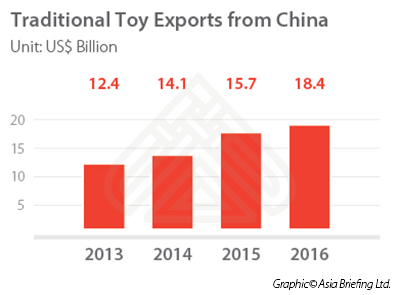Child’s Play: Opportunities in China’s Toy Industry
 China’s toy industry posted strong growth in 2016, countering recent trends in China’s light industry sector. While China’s total exports dropped by 7.7 percent and imports by 5.5 percent in 2016, toy exports rose by 9.5 percent and imports by 23 percent.
China’s toy industry posted strong growth in 2016, countering recent trends in China’s light industry sector. While China’s total exports dropped by 7.7 percent and imports by 5.5 percent in 2016, toy exports rose by 9.5 percent and imports by 23 percent.
Although lower cost manufacturing locations in India and Vietnam have attracted investor attention, China’s toy industry has been performing well due to a shift in the country’s burgeoning domestic consumer market and advanced manufacturing processes. Given the maturity of the industry, however, foreign investors must be strategic when entering the market to compete with established players.
Market overview
China is the world’s largest toy manufacturer, producing around 70 percent of the world’s supply. Total export value of toys reached US$33.7 billion in 2016. Of this, traditional toys, including dolls, puzzles, educational toys, etc., were valued at US$18.4 billion. Most of China’s exported toys are produced by OEMs who manufacture for foreign brands.
China has numerous toy industry clusters along its affluent east coast. Guangdong province alone produces over half of the world’s toys, with the cities of Dongguan, Foshan, Shantou, and Shenzhen leading the way. Other major toy production sites include the cities of Yiwu, Yunhe, and Wenzhou in Zhejiang province; Yangzhou in Jiangsu province; and Linyi and Qingdao in Shandong province.
The city of Jiaxing in Zhejiang province has also emerged as a major toy producer after Danish toy manufacturing giant, LEGO, opened its first Asian plant there. The 160,000 square meter plant will eventually employ some 1,200 workers and produce 80 percent of LEGO products to be sold in Asia.
Overall, there are more than 10,000 toy manufacturers in China. Collectively, they employ around six million workers.
Both Chinese and foreign manufacturers have been investing heavily in automation and R&D to increase efficiency and offset rising labor costs. Additionally, the increasing popularity of more complex and higher-tech toys is fueling the need for more advanced technology and production methods, as well as higher skilled employees.
![]() RELATED: Pre-Investment and Entry Strategy Advisory from Dezan Shira & Associates
RELATED: Pre-Investment and Entry Strategy Advisory from Dezan Shira & Associates
Favorable demographics
Low cost manufacturing initially drove China’s toy industry, but the emergence of a massive domestic consumer market has fostered its continued growth. The China Toy & Juvenile Products Association projects that China’s toy market will grow by 9.2 percent in 2017 to reach RMB 60.7 billion (US$8.8 billion).
China’s rapidly rising income levels have made the country a giant consumer across a growing number of industries. However, it is not only soaring wealth that is increasing toy consumption.
The abolition of the one-child policy in late 2015 in favor of a two-child policy is expected to bring an influx of newborns, which should lead to increased demand for toys in the short to medium term.
According to the Hong Kong Trade and Development Council, the two-child policy will lead to an additional 2.4 million babies born in China each year, contributing RMB 75 billion (US$11.5 billion) to the toy industry.
In total, the National Health and Family Planning Commission expects the number of newborns to hover between 17.5 million and 21 million annually over the next five years. Currently, there are about 226 million children under the age of 14 in China.
According to Chinese e-commerce website Baobei360, which concentrates on baby products, the average amount spent on toys per child under the age of 16 in China is less than US$30, compared to over US$200 in the US. This suggests that there is still significant growth potential in toy spending per child, particularly given that Chinese parents have consistently shown a willingness to invest heavily in their children.
Despite the implementation of the two-child policy, many families in the wealthier first-tier cities do not plan on having a second child, largely due to the high cost of living. For example, only 10 percent of eligible couples in Beijing said they would take advantage of the two-child policy. Rather, it is China’s less developed, but increasingly affluent lower tier cities where the birth rate is expected to be higher.
Subsector opportunities
Given the industry’s growth potential, the competition is intense, both in term of cost and innovation. Traditionally, foreign brands dominate the higher end of the market, while domestic brands control the lower to middle end of the market.
Electronic toys that are more interactive than traditional toys have strong growth potential. This is true for both conventional toys, like action figures, as well as experimental products, such as virtual reality and intelligent toys. Toys that are both interactive and educational are a particularly popular subsector, especially among parents.
Plush toys that depict cartoon characters are popular both among children and adults of all ages, and are often used for decorative purposes. Although homegrown Chinese cartoon characters are slowly gaining prominence, this sector is still dominated by Japan and the US, and South Korea to a smaller extent.
The popularity of foreign cartoon characters offers ample opportunities for licensing. However, despite improvements in IP protection, counterfeit products are still rife. Foreign investors should therefore make concerted IP protection efforts when entering the market.
![]() RELATED: Investing in China’s Education Industry
RELATED: Investing in China’s Education Industry
Industry outlook
Although China’s toy industry has outperformed light industry as a whole, it still faces challenges going forward. Intense competition among domestic toy manufacturers – many of which compete on cost –drives down margins. Meanwhile, land and labor costs continue to rise, meaning higher upfront investments into higher tech production methods is increasingly crucial. These factors will lead many to consider lower cost alternatives.
However, as evidenced by LEGO’s massive investment in Jiaxing, the sheer size and spending power of the Chinese market can offset many of these challenges. As is the case with many of China’s traditional manufacturing sectors, investments into innovation and automation, and a recalibration towards the domestic consumer market are keys to take advantage of the Middle Kingdom’s economic restructuring.
|
China Briefing is published by Asia Briefing, a subsidiary of Dezan Shira & Associates. We produce material for foreign investors throughout Asia, including ASEAN, India, Indonesia, Russia, the Silk Road, and Vietnam. For editorial matters please contact us here, and for a complimentary subscription to our products, please click here. Dezan Shira & Associates is a full service practice in China, providing business intelligence, due diligence, legal, tax, IT, HR, payroll, and advisory services throughout the China and Asian region. For assistance with China business issues or investments into China, please contact us at china@dezshira.com or visit us at www.dezshira.com
|

Dezan Shira & Associates Brochure
Dezan Shira & Associates is a pan-Asia, multi-disciplinary professional services firm, providing legal, tax and operational advisory to international corporate investors. Operational throughout China, ASEAN and India, our mission is to guide foreign companies through Asia’s complex regulatory environment and assist them with all aspects of establishing, maintaining and growing their business operations in the region. This brochure provides an overview of the services and expertise Dezan Shira & Associates can provide.
An Introduction to Doing Business in China 2017
Dezan Shira & Associates´ Silk Road and OBOR investment brochure offers an introduction to the region and an overview of the services provided by the firm. It is Dezan Shira´s mission to guide investors through the Silk Road´s complex regulatory environment and assist with all aspects of establishing, maintaining and growing business operations in the region.
New Considerations when Establishing a China WFOE in 2017
In this edition of China Briefing, we guide readers through a range of topics, from the reasons behind foreign investors’ preference for the WFOE as an investment model, to managing China’s new regulations. We discuss how economic transformations have favored the WFOE, as well as the investment model’s utility, and detail key requirements that businesspeople need to examine before initiating the WFOE setup process. We then walk investors through the WFOE establishment process, and, finally, explain the new and idiosyncratic “Actual Controlling Person” regulation.
- Previous Article Expecting in China: Employee Maternity Leave and Allowances
- Next Article China’s FIE Registration and the New Actual Controlling Person Requirement













